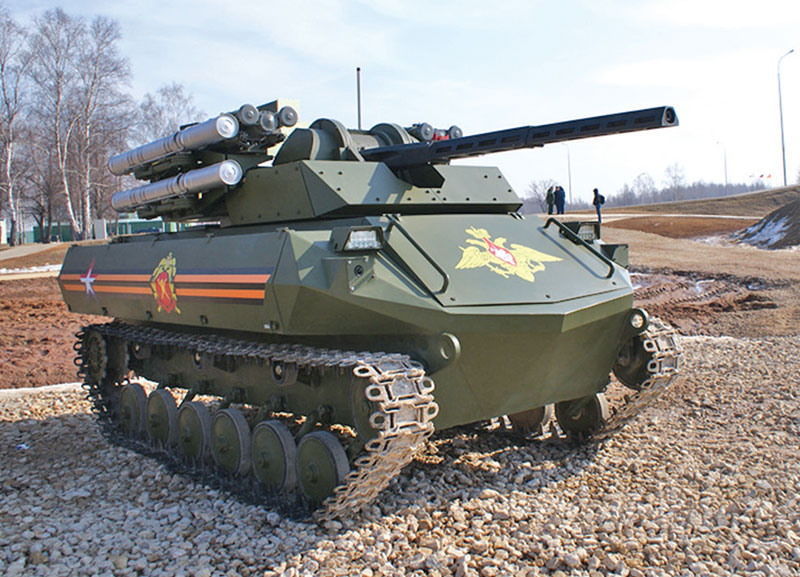India should invest much more in unmanned ground systems for better intelligence gathering
Smruti D
Over the decades technological innovations have found their way into military establishments of a number of countries. The widening purview of security-related challenges have internally and externally compelled military establishments to develop and induct Artificial Intelligence (AI) into their systems. This technology, which initially aided operations, has now become the key to intelligence gathering. The growth of unmanned ground systems (UGS) is a result of the same.

Unmanned ground systems include unmanned ground vehicles and sensors. They help in situational awareness, reconnaissance and surveillance, target acquisition, disarming explosives and logistics support. They are fiercely important as they carry out man-power intensive and high-risk functions.
In the Indian context these equipment could prove to be of immense measure to counter terrorism and Left-Wing Extremism (LWE) operations to the road opening parties of the Central Reserve Police Force (CRPF) that are deployed in regions affected by these issues. Buried mines pose a huge risk to the lives of security personnel. Data by National Bomb Data Centre revealed in 2017 that India ranked first in the number of improvised explosive device (IED) bomb blasts in the world, surpassing countries such as Syria, Afghanistan, Turkey, Iraq, Thailand, Somalia, Syria and Pakistan.
While mine-protected vehicles, radars and UAVs (on a smaller scale) are now made available to security personnel, UGVs could be of unparalleled advantage. UGVs can disable, detect and destruct without human assistance. They can also be armed, saving human contact or confrontation in warfare. They can detect the texture of the terrain and obstacles that they come with.
In India, there is huge potential and the requirement for UGVs. The Defence Research and Development Organisation (DRDO) has started the process but it’s long way from achieving success. DRDO’s Combat Vehicles Research and Development Establishment (CVRDE) has come up with UGVs for the armed forces. The Muntra project, which is India’s first unmanned tank, has three versions namely, Muntra-S, Muntra-M and Muntra-N, which can undertake surveillance, mine detection and reconnaissance in areas with bio and nuclear threats.
Muntra-S is a tracked amphibious BMP II ICV designed and developed for unmanned surveillance of ground and sea targets. The vehicle can detect targets ranging from crawling men to group of vehicles, small boats to large ships which can classify the target automatically, among other functions.
Muntra-M is an all-weather, day and night capable tracked amphibious BMP II LCV designed for Unmanned mine detection and marking missions. The vehicle boasts of a Ground Penetrating Radar (GPR) and Vapour Detection System (VDS) which can detect mines at a standoff distance.
Muntra-N is a tracked amphibious BMP II ICV designed and developed for unmanned NBC reconnaissance missions, capable of autonomous navigation, deployable in all weather, day and night. It is capable of detecting nuclear radiations like Gamma/X-rays, chemical warfare agents like H&G agents, biological agents like virus, bacteria, spores and biological toxins, industrial chemicals with weather measurements, remotely fired steel pickets. Muntra-N is also capable of collecting solid, semi-solid and air samples.
There are also unattended ground sensors (UGS) that ‘detect, track and identify human and vehicular enemy targets, thus, enabling total control and terrain dominance’. Elbit systems has come up with Primose Wireless Sensor Networks that are self-powered and can detect and track human and vehicle movement. Elbit Systems says that its sensors have ‘high probability-of-detection (PD) and low false alarm rates (FAR)’. The UGS that Elbit Systems offers are Primrose Wireless Sensor Networks and TREASURES.
Elbit Systems, describes the Primose Wireless Sensor Network, as comprising miniaturised and spatially-distributed remotely monitored sensors, these wireless networks are standalone, self-powered, and can detect and track the movements of people, vehicles, and other events. Several Primrose networks can be joined together to safeguard an even larger zone. The system utilises advanced energy saving technology and is easily customisable to meet the needs of a wide range of missions.
TREASURES UGS system, on the other hand, enables full situational awareness and round-the-clock border protection by facilitating a quick and efficient sensor-to-shooter cycle. It detects, classifies and tracks human and vehicular targets in real time, on any terrain, and in all-weather conditions. The system uses a broad network of sensor clusters, breakthrough sensing technologies, dedicated communications protocols and robust data analysis capabilities. It’s a small form factor, light-weight components, low maintenance and has rapid deployment time.
Textron Systems is also one global firm that is working in the area of unmanned ground sensor systems. In February 2014, Bharat Electronics Limited (BEL) signed an MoU with Textron for unattended ground sensor system to the Indian security agencies. This MoU was signed during the DefExpo 2014 where they said, “The MicroObserver UGS system brings a new level of covertness, ease of use and performance for border security, surveillance and critical infrastructure protection missions. Textron Systems reports that its MicroObserver system has been fielded around the world in support of these applications.” Unmanned ground sensors is an area that Indian research and development can delve into and explore more. Most companies worldwide are looking to enhance their intelligence in unmanned systems, especially the sensors. The statement, ‘data is the new oil’ (by Clive Humby) stands true for armed forces. The more intelligence-related data a military has, the more it can be combat-ready.
You must be logged in to view this content.

